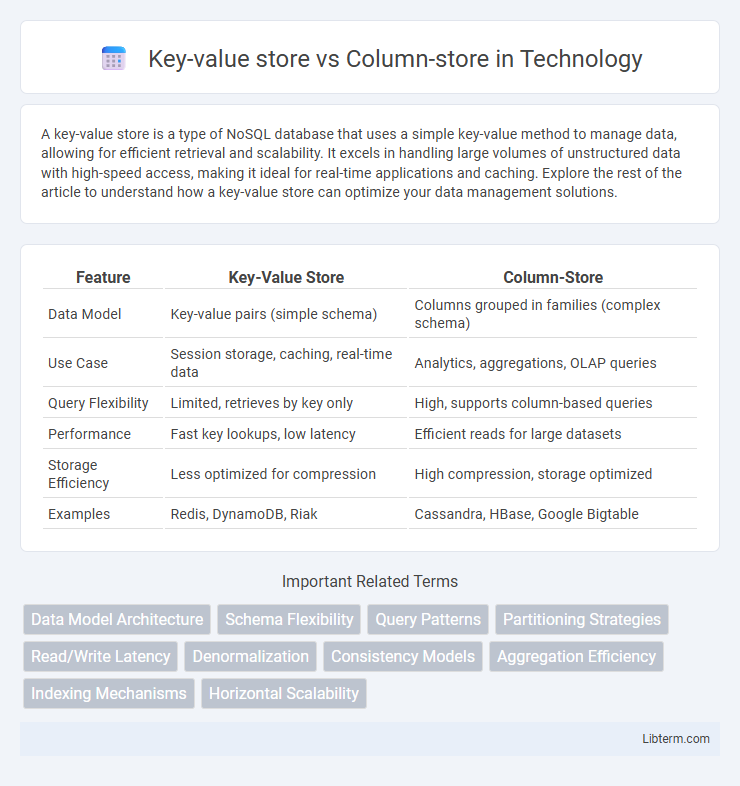A key-value store is a type of NoSQL database that uses a simple key-value method to manage data, allowing for efficient retrieval and scalability. It excels in handling large volumes of unstructured data with high-speed access, making it ideal for real-time applications and caching. Explore the rest of the article to understand how a key-value store can optimize your data management solutions.
Table of Comparison
| Feature | Key-Value Store | Column-Store |
|---|---|---|
| Data Model | Key-value pairs (simple schema) | Columns grouped in families (complex schema) |
| Use Case | Session storage, caching, real-time data | Analytics, aggregations, OLAP queries |
| Query Flexibility | Limited, retrieves by key only | High, supports column-based queries |
| Performance | Fast key lookups, low latency | Efficient reads for large datasets |
| Storage Efficiency | Less optimized for compression | High compression, storage optimized |
| Examples | Redis, DynamoDB, Riak | Cassandra, HBase, Google Bigtable |
Introduction to Data Storage Models
Key-value stores organize data as a collection of key-value pairs, allowing rapid access to values via unique keys, making them ideal for simple, fast retrieval scenarios such as caching and session management. Column-stores, by contrast, store data tables by columns rather than rows, optimizing analytical queries that aggregate large datasets across specific columns, common in data warehousing and business intelligence. Understanding these storage models helps tailor database solutions to specific workloads, balancing speed, scalability, and query complexity.
What is a Key-Value Store?
A key-value store is a type of NoSQL database that stores data as a collection of key-value pairs, where each unique key is associated with a specific value, enabling fast and efficient data retrieval. Key-value stores are optimized for scenarios requiring simple lookups, quick transactions, and scalable data storage, commonly used in caching, session management, and real-time applications. Unlike column-store databases that organize data by columns to optimize analytical queries, key-value stores prioritize high-performance access to individual data objects without complex querying capabilities.
What is a Column-Store?
A column-store is a database architecture that organizes data tables by columns rather than rows, enabling faster read and write operations for analytical queries that access specific columns. This layout improves compression and disk I/O efficiency, making it ideal for big data and business intelligence applications requiring high-speed aggregations and scans. Unlike key-value stores, which focus on simple key-based retrieval, column-stores excel in handling complex queries across multiple attributes in large datasets.
Core Differences Between Key-Value and Column-Store
Key-value stores organize data as a collection of key-value pairs optimized for fast lookups and scalable transactions, ideal for caching and session management. Column-store databases store data by columns rather than rows, enabling efficient querying and aggregation on large datasets, which is beneficial for analytical workloads and business intelligence. The core difference lies in data retrieval patterns: key-value stores excel in quick access to individual items via unique keys, while column-stores optimize read performance for specific columns across many rows.
Data Modeling in Key-Value vs Column-Store
Key-value stores organize data as simple key-value pairs, making them highly efficient for scenarios requiring fast lookups and flexible schema design without complex relationships. Column-stores arrange data by columns rather than rows, optimizing read and aggregation performance for analytical queries but requiring more structured, pre-defined schemas to leverage columnar compression and indexing. Data modeling in key-value systems prioritizes scalability and simplicity, while column-stores focus on query performance and efficient storage of related attributes within columns.
Performance Considerations
Key-value stores excel in handling large volumes of simple read and write operations with low latency due to their straightforward data model, making them ideal for caching and session management. Column-stores optimize performance for analytical queries by storing data in columns rather than rows, enabling efficient compression and faster access to specific attributes in large datasets. Performance in key-value stores can degrade with complex queries, while column-stores provide significant speed improvements in OLAP workloads by reducing I/O and improving CPU cache utilization.
Scalability and Flexibility
Key-value stores excel in scalability by distributing data across multiple nodes with simple, fast lookups, making them ideal for high-throughput applications. Column-stores offer flexibility in querying large datasets by efficiently reading only relevant columns, optimizing analytical workloads. Both systems scale horizontally, but key-value stores prioritize low-latency access while column-stores enhance flexibility through schema-oriented data organization.
Use Cases and Applications
Key-value stores excel in managing large volumes of unstructured data, making them ideal for caching, session management, and real-time recommendations in e-commerce platforms. Column-store databases optimize analytical query performance by efficiently storing and retrieving specific columns, which is crucial for business intelligence, data warehousing, and time-series data analysis in industries like finance and telecommunications. Choosing between key-value and column-store depends on workload characteristics: key-value suits high-throughput transactional workloads, while column-store supports complex aggregations on large datasets.
Pros and Cons Comparison
Key-value stores excel in simplicity and speed for retrieving values by keys, making them ideal for caching, session management, and real-time applications. In contrast, column-stores optimize analytical queries by storing data in columns, enhancing compression and query performance on large datasets but often sacrificing transactional support and update speed. Key-value stores lack complex querying capabilities, while column-stores may incur overhead for simple key-based lookups, defining their distinct use cases and performance trade-offs.
Choosing the Right Store for Your Needs
Key-value stores excel in handling simple, fast lookups with flexible schemas, making them ideal for caching and session management where speed and scalability are critical. Column-stores optimize analytical queries by efficiently storing and retrieving data in columns, enhancing performance for read-heavy workloads and complex aggregations in data warehousing. Selecting the right store depends on workload characteristics: choose key-value stores for low-latency transactional operations and column-stores for large-scale analytics and business intelligence tasks.
Key-value store Infographic

 libterm.com
libterm.com